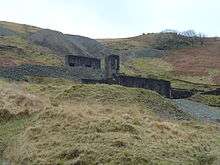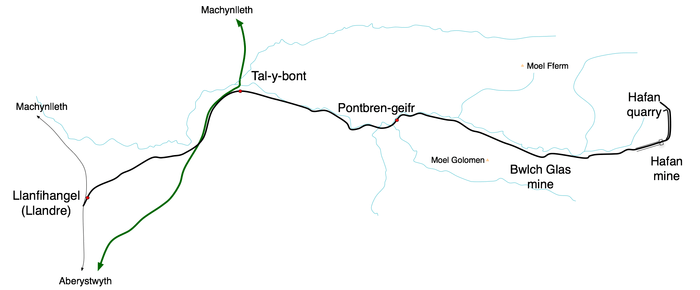Plynlimon and Hafan Tramway
Coordinates: 52°44′38″N 3°21′36″W / 52.744°N 3.360°W
| Locale | Wales |
|---|---|
| Dates of operation | 1897–1899 |
| Successor | abandoned |
| Track gauge | 2 ft 3 in (686 mm) |
| Length | 7 3⁄4 miles (12.47 km) |
| Headquarters | Talybont |
The Plynlimon and Hafan Tramway was a 2 ft 3 in (686 mm) gauge narrow gauge railway in Cardiganshire (now Sir Ceredigion) in Mid Wales. It ran from Llanfihangel (later renamed Llandre) station on the Cambrian Railways via the village of Talybont and the valley of the Afon Leri into the foothills of Plynlimon Fawr. It was built to serve the lead mines at Bwlch Glas and stone quarries around Hafan[1] and opened in 1897, closing just two years later. The line was a little over 7 miles (11 km) long and despite running a short-lived passenger service, it served no communities of more than 100 people.
History
Background: before 1895

Mining of minerals in the hills east of Talybont in Mid-Wales dates back as far as 1698, with the Hafan Mine, which principally produced lead ore, but also copper ore and zinc.[2]
In 1890, Captain John Davis of Talybont and Thomas Molyneux, an industrialist of Earlestown in Lancashire, joined forces to exploit minerals from local mines including Hafan Mine, and to develop grit stone quarries on Hafan mountain.[3] Molyneux proposed building a tramway from Hafan to the coast at Ynyslas using the Leri Valley - Hafan/Talybont/Dolybont and run down and across Cors Fochno using the canalised embankment of the Leri diversion constructed by the Aberystwyth & Welsh Coast Railway, to a Dock suitable for coasters at Ynyslas. However the Cambrian Railways would not permit the tramway to cross its line at any point between Machynlleth and Aberystwyth, leaving no alternative but to unload into barges to get under the bridge at Ynyslas, and then tranship to coasters from the barges the other side. Much thinking went on as to how to get to the sea elsewhere: in frustration, Clarach Bay was considered but ship loading would have been very difficult, a tramway under Ynyslas bridge was considered but discounted due to obvious tide problems, even a line alongside the main line to Aberystwyth Harbour was considered, the transhipping at Ynyslas was discounted as too costly a procedure. In the end it was decided the only option was to go to the Cambrian Railways. Llandre Station, even though Mr Molyneaux had previously stated that much benefit would be lost by their not having direct Port access... however, this option was the only way in the end.
Construction commenced on 11 January 1896, but was briefly brought to a halt by the Gogerddan Estate as the route had not been finalised or indeed agreements signed. Some months afterwards construction commenced in ernest, and very impressive progress was made. The mines and tramway to this point had been funded totally by Thos.Molyneaux, but on the 24th of Oct. 1896 he sold his holdings to the Plynlimon & Hafan Co.Ltd. for £14,000 of the new company's Ordinary shares - meaning he held a 46.6 holding in this new company, and became its Managing Director - with his son holding the post of General Manager and Engineer (having been involved for some while).
By late 1896 the track bed of the line was largely complete. After much delay, track materials were delivered in January 1897, with the first rails being laid at Talybont on 11 January. Tracklaying progressed quickly and in May the first locomotive Victoria arrived on site. During December, Mr Molyneaux had asked Sir P.P.Pryse "...to try to get Sir James Szlumper to adopt the P&H gauge of 2'3" for the proposed Devils Bridge line", and had this happened things would have been interesting and possibly very different, but it did not due to the sharp curves of the Devil's Bridge line.
The first test run of Victoria was a limited success. On 5 June another attempt was made with the locomotive propelling two trollies and pulling a third. Just before Glanfred level crossing a piece of timber was spotted lying across the rails. One of the men on the train, Richard Roberts went forward to clear the line but fell underneath the train and was killed.
In August 1897 the second locomotive Talybont arrived along with the line's first passenger carriage. On 19 August a trial train was run as far as the bottom of the Hafan incline, although the track between Llanfihangel and Talybont was not laid to a high enough quality to permit passenger services to begin immediately.
From late 1897 freight service began on the line. The formal opening to passengers took place on 28 March 1898, although trains only ran on Mondays, connecting with the Cambrian Railway's Market Day Special to Aberystwyth. The majority of passenger trains in the line's short history stopped at Talybont as there were few houses to be served further east of that village.
The passenger service only ran until the summer of 1899 and the entire company went into voluntary liquidation on 19 December 1899 the last train having run sometime before that date. Not long after closure, the company operating the Bryn-yr-Afr Mine made inroads to reopen the line to serve their needs, but nothing came of it unfortunately. There was also a proposal to re-open the line as late as 1910.[4] However, this also came to nothing. The track remained in place until 1914 when it was taken up, though the stretch of line through the Bwlchglas Farm property remained intact until scrapped by the landlord in 1926.
Route


The main line (which was marked by steep gradients) terminated at the foot of the Hafan Incline, while a mineral extension led from the top of the incline to a granite sett quarry operated by the little Bagnall 0-4-0.
The Plynlimon and Hafan was one of the most obscure common carrier railways in Britain. It shared its unusual gauge with only three other public railways in Britain: the nearby Corris Railway and Talyllyn Railway and the later Campbeltown and Machrihanish Light Railway in Scotland.
Molyneaux's use of this gauge may indicate a somewhat optimistic idea of connecting to the Corris and Talyllyn railways, and he also unsuccessfully pressed the promoters of the Vale of Rheidol Railway to adopt the same gauge, which if adopted would have created a 2'3" haven in the area in contrast to the 2' gauge lines around Porthmadog. Since the Corris had originally had access under the Cambrian line at Machynlleth for its horse-worked extension to Morben, it might have been possible to revive this section of line as a linking route, but it was another step again to link to Talyllyn metals. However, the P&H's loading gauge was both taller and wider than its two northern neighbours, and so none of its rolling stock could have been used on either Corris or Talyllyn, suggesting that no link was seriously contemplated. This also meant that neither line were interested in buying any of the P&H rolling stock after it closed.
Molyneaux had proposed a tunnel under Hafan so to serve the Bryn-yr-Afr Mine, but this was only a dual step in the 'grand plan' for a connection south to the Devils Bridge line and the other northerly connections that were on Mr Molyneaux's mind.
Today the trackbed formation from Pontbrengeifr to the Hafan incline remains largely open and intact and can be walked; much of the formation of the mineral extensions at the top of the incline is also traceable. Between Pontbrengeifr and Talybont sections of the formation remain intact, but others have been eroded away by the Afon Leri and are heavily overgrown which makes walking it more difficult. There is now little to see of the former exchange sidings at Llandre.
Locomotives
The tramway owned three steam locomotives.
- "Victoria" was the only locomotive built by Messrs John Slee & Co of Warrington. It was an 0-4-0 of highly unusual design, with a vertical boiler and tram-like bodywork. Some sources report that the locomotive originally had four cylinders, but two were later disconnected as the boiler could not supply enough steam to power four.[5] Victoria was delivered to Llanfihangel on 12 May 1897. The locomotive did not run well and is not known to have ever run in revenue-earning service. Its intended duties on the main line were taken over by "Talybont".[6]
- "Talybont" 2-4-0T was a conventional design built by W.G. Bagnall, originally for a customer in Brazil who cancelled the order. It worked the main line from Llanfihangel via Talybont to the foot of the Hafan incline.
- "Hafan", Bagnall 0-4-0 ST works number 1510, ran on the quarry section above the Hafan incline. Repurchased by Bagnall in 1901 and subsequently worked on the Halifax Corporation's Walshaw Dean Reservoirs construction contract for which she was regauged to 3 ft (914 mm). After several further reservoir construction contracts she was last noted working at the Bedley Timber Company at Nairn, Scotland in 1920.[6]
Both the Bagnalls were returned to the makers after the line closed, while "Victoria" was probably scrapped. "Talybont" was regauged and sold on to the Vale of Rheidol Railway and became their No.3 "Rheidol", while "Hafan" went on to work on reservoir contracts.
Passenger Carriage
The tramway had only one passenger carriage, a rather ornate vehicle with end balconies and clerestory roof. Legend has it that after the tramway closed it was used as a shed on a farm or garden, but if this was the case it probably disappeared many years ago. Although the original does not survive a replica has been built and is running on the Launceston Steam Railway.
Goods Vehicles
Some of the tramway's waggons accompanied "Talybont" to the Vale of Rheidol, and, much rebuilt, remain there to this day.
See also
References
- ↑ 52°45′58″N 3°16′30″W / 52.766°N 3.275°W
- ↑ Wade, page 16
- ↑ Wade, pages 18-19
- ↑ "Cardigan County Council. Annual Meeting at Lampeter. Lead Mining Revival.". Aberystwyth Observer. 24 March 1910. Retrieved 13 October 2014.
- ↑ Weaver, Rodney (1984). "Victorian Refections". The Narrow Gauge. The Narrow Gauge Railway Society.
- 1 2 Wade, E.A. (1997). The Plynlimon & Hafan Tramway. Twelveheads Press. ISBN 0-906294-38-X.
Bibliography
- Cozens, Lewis (1955). The Plynlimon & Hafan Tramway.
- Boyd, J.I.C. (1986). Narrow Gauge Railways in Mid Wales. The Oakwood Press.
- Wade, E.A. (1997). The Plynlimon & Hafan Tramway. Twelveheads Press.
External links
| Wikimedia Commons has media related to Plynlimon and Hafan Tramway. |